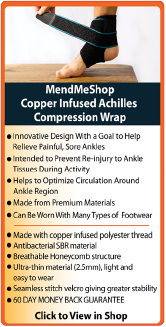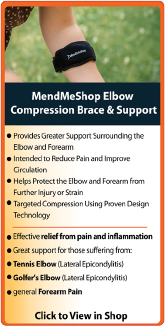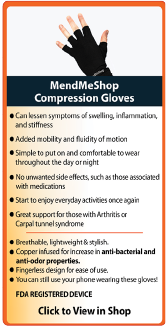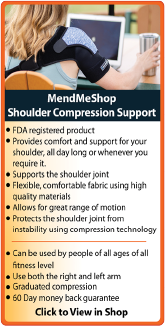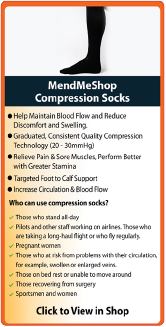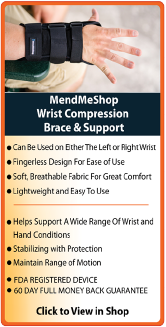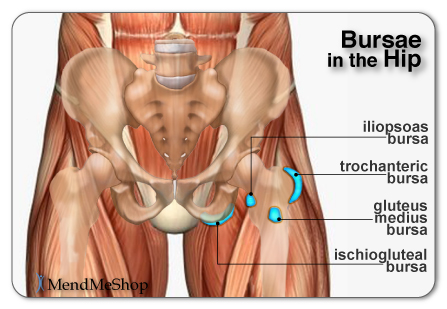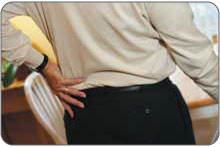Hip BursitisTrochanteric BursitisThe trochanter bursa functions to prevent the iliotibial band (IT band) from rubbing against the greater trochanter of the femoral head. The IT band runs from the iliac crest (crest of the pelvis) down the side of the hip and leg, and inserts at the upper tibia (top of the knee.) It is mainly used along with the gluteus maximus for bracing the leg and knee when in the standing position. Trochanteric bursitis most often results from the iliotibial band (IT Band) tightening and rubbing against the bursa.  The IT band is made up of thick, fibrous tissue that is considered connective tissue similar to a tendon. When it becomes irritated or inflamed, it can irritate the trochanter bursa causing inflammation within the bursa. Therefore, sufferers of iliotibial band syndrome (ITBS) may experience trochanteric bursitis at the same time. Trochanteric bursitis is often used as a general term to describe pain around the greater trochanteric region of the hip and is often confused with Greater Trochanter Pain Syndrome (GTPS). Trochanteric bursitis is ONE of many component that make up GTPS - the other notables relating to conditions that cause pain in the lateral side of the hip. Read more about trochanteric bursitis here. Iliopsoas BursitisThe iliopsoas bursa lies between the front of the hip bone and the iliopsoas muscle, helping reduce friction between this bone and muscle. This bursa usually becomes inflamed due to overuse of the iliopsoas muscle. Overuse can tighten the muscle, causing more pressure on the bursa when the hip is flexed. Iliopsoas bursitis can be mistaken for tendinitis or hip arthritis because of the location of pain and other symptoms. Read more about iliopsoas bursitis here. Ischialgluteal BursitisThe ischial bursa is located at the bottom of the ischium (lower hip bone). It cushions the gluteus maximus muscle from the ischium when sitting on hard surfaces or when sitting for long periods of time. Ischial bursitis may cause back pain and due to the location, it is often mistaken for sciatica pain. General Information about BursitisImportant: In some cases, an inflamed bursa may become infected with bacteria (referred to as septic bursitis) and this can quickly become life threatening! In all cases where you suspect you may have bursitis, see a physician for full diagnosis. If the bursa is septic, getting to a doctor quickly may save your life. There are two types of bursitis: chronic and acute. Chronic bursitis is caused by overuse or repetition of a certain area or joint. It will develop over time, and will likely get better and flare up over a long period of time. Acute bursitis is often the result of a trauma to the hip, such as a fall. It can also result from a simple movement such as lifting and twisting the wrong way or may come on quickly following irritation during hip surgery. Some suffers cannot recall what triggered the hip pain, which is why some will not seek treatment, hoping it will resolve itself. However, it is always wise to address and treat hip pain as soon as possible so that the problem does not worsen. Hip Bursitis SymptomsA healthy trochanter bursa is usually about the size of a small plum, but can swell to the size of an orange when bursitis sets in. This is what creates the soft tissue damage in the area. Other symptoms you may experience include:
Hip Bursitis CausesBursitis of the Hip has been found to be statistically more prevalent in cases where the sufferer is involved in, or experiences one or more of the following factors: 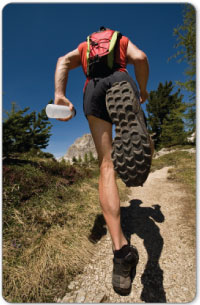
The Painful Symptoms of Acute & Chronic Hip BursitisIf you have hip bursitis, you will mainly feel pain and experience swelling right at the side of your hip. The side of your hip will feel tender at first and you may feel pain when you press on the outside of your hip. Pain can sometimes radiate down the outside of your thigh or into your butt.  The pain you'll feel for acute (short-term) vs. chronic (long-term) hip bursitis will be different. In the beginning you might feel a sharp, intense pain at your hip. The longer you have this injury the more this pain will spread out into more of an achy feeling. One clear sign that you've re-injured your hip while recovering from hip bursitis is feeling that sharp, intense pain again if you've overworked it. If you feel more pain at night while lying on your injured hip or performing activities like walking, squatting / bending down and climbing stairs then you might have a moderate case of hip bursitis. You may even notice an intense pain while getting up from a seated position - especially if you have a desk job, spend a lot of time seated on the couch or a kitchen chair during your "down time" or drive in your car for long distances. Over time, if left untreated, you will start noticing more and more constant pain and have trouble sleeping at night. As I mentioned before, if this injury is left untreated you might need to get your bursa removed through surgery (a bursectomy). You might even suffer from "septic" bursitis - where your bursa gets infected by a bacteria. On-going pain, chronic swelling, or symptoms of an infection (fever or a general sick feeling) should be treated immediately by a doctor. What Should I Do?If you think that you're suffering from hip bursitis and your hip mobility is steadily declining the first thing you need to do is see your doctor. Only your doctor can give you a proper diagnosis and from this, determine a course of proper treatment. If you've been diagnosed with hip bursitis,
... and Re-injury to your hip must be avoided at all costs!Time is no friend to an immobilized joint - you lose strength in your hip but worse than that, you lose the range of motion from atrophy (your flexible tendons, muscles and ligaments slowly shrink / waste away, decreasing joint elasticity). The more time that goes by with your hip immobilized, the more likely you'll wind up with a chronic hip problem (long term injury such as tendonitis or chronic inflammation / bursitis pain). Basically it means that your hip won't perform as well as it once did and it becomes more prone to injury again later on. If you have an inflamed bursa in your hip, it's very important to heal it quickly and completely. Minimizing the healing time of your hip bursitis should be an obvious goal, as hip bursitis will limit your ability to go about your daily routine. As stated here on MedicineNet.com, if your long-term (chronic) hip bursitis is left untreated, calcium deposits can form within the bursae. These calcium deposits can lead to permanent stiffness in your injured hip. Dealing with continuous re-injury, chronic inflammation / swelling and the possibility of getting calcium deposits means you'll have a greater chance of winding up with a chronic hip condition or a serious case that needs to be resolved with surgery. You need to avoid chronic inflammation and the potential for developing calcium deposits. If you don't, your hip bursitis injury may plague you forever. This is why it's so important to continuously use conservative treatment tools to heal any recurring soft tissue damage and swelling from your bursa before it can build into something big. For any hip bursitis sufferer, having the right tools makes all the difference. Treatments for Hip BursitisRelieving the symptoms of bursitis initially focuses on keeping the pressure off the bursa. Surgery may be required if your bursa irritation is a result of a bone formation problem, such as a bone spur. If your bursitis is caused by an infection (septic bursitis), the doctor will probably drain the bursa sac with a needle and prescribe antibiotics to treat the infection. For non-infectious bursitis, the preliminary treatment starts with non-operative options such as cold compression via use of a Cold Compress or Ice Pack. The most important factor in healing bursitis is resting your hip. This can be difficult when you have to carry on with daily activities, but resting whenever you can is recommended. During your recovery you will probably have to modify or avoid the activities that stress your bursa until your pain and inflammation settle. Treatments should involve decreasing swelling, relieving stress on the hip joint, correcting any bio-mechanical dysfunction (uneven leg length, bone spur, etc.), treating scar tissue, and then finally restoring strength and movement in your leg and hip. A TShellz Wraps® are recommended once inflammation has been calmed as these wraps are intended to enhance localized blood flow (the conduit for the body's internal soft tissue healing mechanism) and the warmth generated from the wrap is intended to increase flexibility of soft tissue in the treatment area as well. Read more about Bursitis Treatments here. Anti-Inflammatory Medications for BursitisNSAIDs, non-steroidal anti-inflammatory drugs, can be used if required to help manage your pain. However, these aren't recommended for long term use, as they can cause gastrointestinal difficulties and increase the risk of cardiovascular disease. The TShellz Wrap®, when used in conjunction with NSAIDs can greatly improve the effect of the medication; this can not only help you heal quickly but also reduce the amount of NSAIDs that you ultimately may require. Surgical Procedures for BursitisYour doctor may aspirate your inflamed bursa. This involves removing the extra fluid that has built up with a needle. Sometimes, the fluid will be tested at a laboratory to rule out infection. 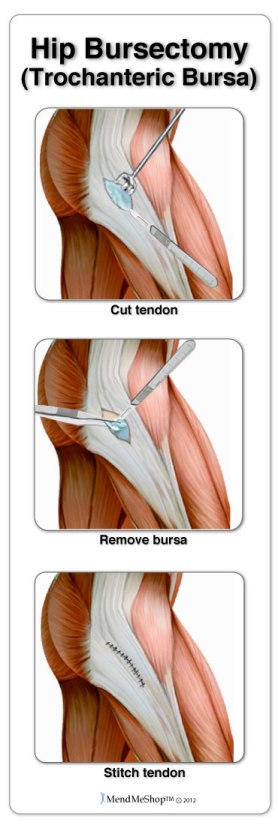 If your bursitis does not get better with conservative treatments, the bursa may be surgically removed. Usually this is done by hip arthroscopy, which is a surgical procedure where tiny incisions are made and a pencil-sized camera is inserted into the hip. A small shaver is inserted into another incision, and is used to remove the swollen bursa all together. The surgeon will then look for any damage to the hip and make repairs if necessary. This is also done to remove any bone spurs. Recovery time for the surgery will depend on a number of different factors including your healing ability, diet, rest and how many procedures were done in your surgery. Post-op recovery time can be reduced with the use of Cold Compress or Ice Pack cold compression treatment and Circulation Boost following surgery. Cold compression is recommend by doctors following surgery to treat your pain in a natural, non-addictive way and to reduce swelling. Once the incision has healed, speak with your doctor about the use of Circulatory Boost. Circulatory Boost encourages more oxygen and nutrients to flow to the area to speed healing and improve the strength of the soft tissue in your hip. Using the TShellz Wrap® as soon as you can following your surgery will help prevent and minimize the scar tissue that forms as you heal. Treating scar tissue is the most important step following surgery, especially in a joint, to improve the range of motion in your hip. Leaving the scar tissue untreated can lead to stiffness, chronic hip pain, osteoarthritis or other chronic conditions. Rehabilitation Exercise for BursitisPT is a beneficial way to restore atrophied muscles and improve strength and mobility after treating bursitis. The type of PT and the duration will be dependent on the tissue damage and your symptoms. When you are treating or recovering from bursitis, it is important to ensure you do not perform any exercises that will further irritate the bursa. 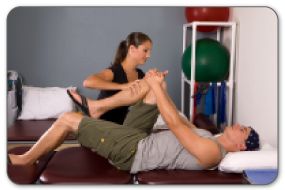 Once your pain starts to diminish, a physiotherapist will set up an individualized strengthening and stretching exercise program for you to perform at home or in the gym. This will be based on your needs and abilities, and will help you return to performing your normal routines. Individuals will often lift weights on their own, to try and build up their strength. However, in doing so, they can do more damage to their joint. It is extremely important to strengthen your muscles properly, as they may have weakened during the period of non-use. A trained therapist will help to ensure your rehabilitation process is appropriate and effective. For best, long term results use TShellz Wraps® at home, in conjunction with PT and an exercise program. We've helped thousands of people treat their painful injuries and conditions to get them back on the road to a pain-free life! Click HERE to Go To Our Online Store We take all major credit cards and Paypal. Our customer service lines are open 5 days a week helping people understand their injuries and how to treat them. Simply call toll free 1-866-237-9608 to talk or place an order with one of our knowledgeable Product Advisers. They have the ability to answer questions and even put together a treatment plan for you. Product Advisors are available 9:00 am to 5:00 pm Eastern Standard Time Monday to Friday. Learn More About Bursitis Injuries & TreatmentsI want to learn more about Post-Surgery Recovery I want to learn more about TShellz Wrap® Circulatory Boost I want to learn more about Ice & Heat: Which Is Better For Treatment? I want to learn more about Bursitis Treatments I want to learn more about Bursitis Surgery FREE SHIPPING ON ALL PRODUCTS CURRENTLY ENABLED |
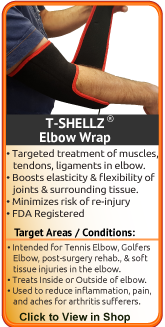  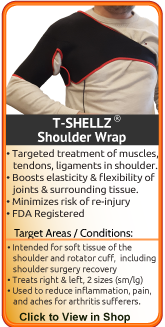 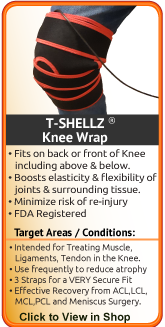 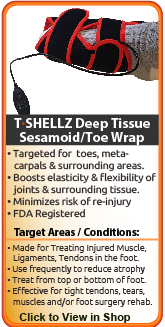 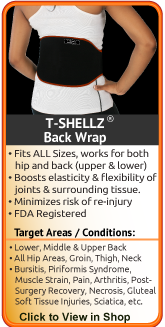 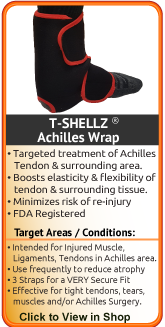 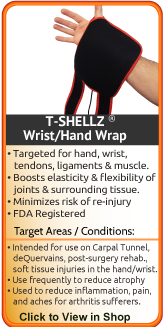 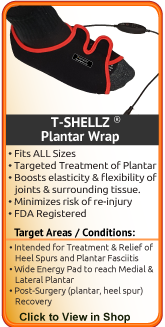  |

